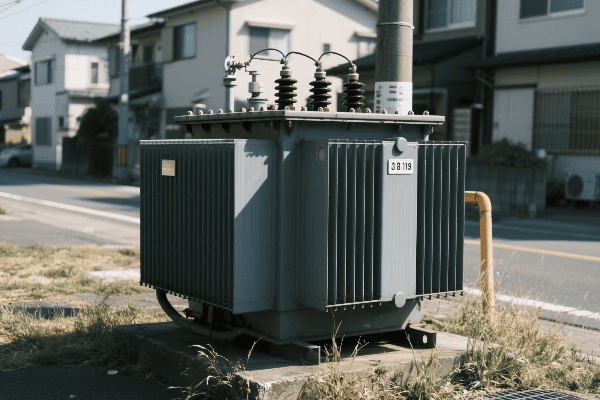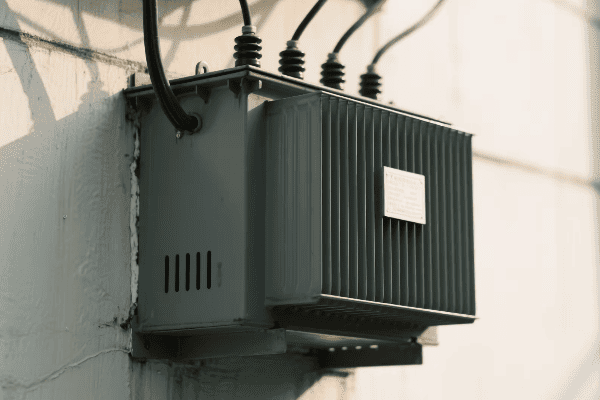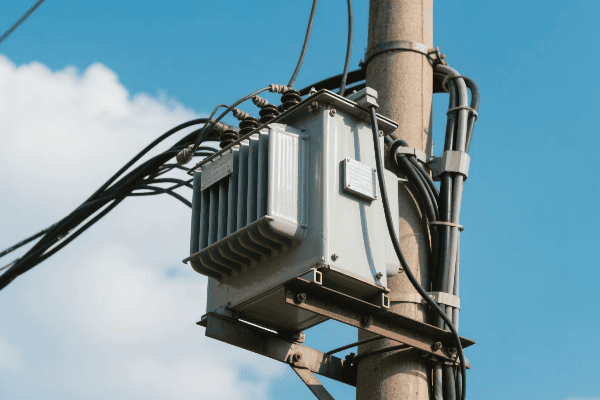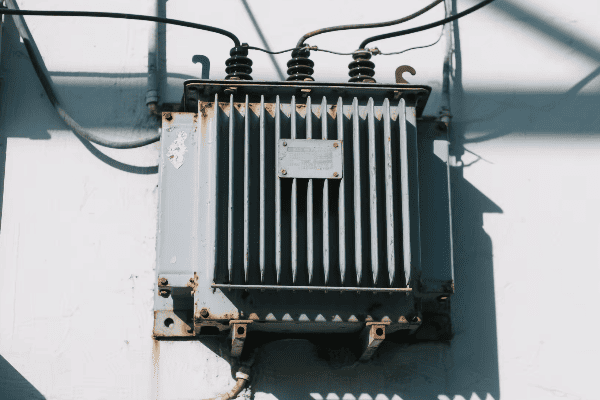What Is an Electrical Transformer and What Does It Do to Ensure Safe Power Distribution?
Have you ever wondered how electricity safely travels from power plants to your home? The answer lies in a crucial device: the electrical transformer. This unsung hero keeps our lights on and our appliances running safely.
An electrical transformer is a device that changes voltage levels in electrical circuits. It ensures safe power distribution by stepping up voltage for efficient long-distance transmission and stepping it down for safe use in homes and businesses. Transformers are essential for the reliable and safe operation of our entire electrical grid.

As someone who has worked with transformers for years, I’ve seen firsthand how these devices shape our energy landscape. They’re not just metal boxes; they’re the guardians of our electrical infrastructure. Let’s dive into the world of electrical transformers and discover why they’re so important for safe power distribution.
How Does an Electrical Transformer Manipulate Voltage for Safe Power Transmission?
Imagine trying to drink from a fire hose. That’s what using electricity straight from a power plant would be like. Electrical transformers make this power usable and safe for us.
Electrical transformers manipulate voltage through electromagnetic induction. They use coils of wire and a magnetic core to step voltage up or down. This process allows for efficient long-distance transmission and safe local distribution of electrical power.

I remember my first day working with a large power transformer. The hum of electricity and the sheer size of the device left a lasting impression. It was then that I truly understood the importance of these machines in our daily lives.
The Basic Principle: Electromagnetic Induction
Transformers work on a simple yet powerful principle:
- Primary Coil: Receives incoming electrical current.
- Magnetic Core: Transfers energy between coils.
- Secondary Coil: Produces outgoing current at a different voltage.
This process allows transformers to change voltage levels without direct electrical connections.
Stepping Up: Preparing for Long-Distance Travel
At power plants, transformers step up voltage:
- Input: Typically 10,000 to 25,000 volts from generators.
- Output: Can be as high as 750,000 volts for long-distance transmission.
- Purpose: Higher voltage means lower current, reducing power losses over long distances.
I once worked on a project to upgrade a power plant’s step-up transformers. We increased the output voltage from 230,000 to 500,000 volts. This change allowed the plant to send power over 300 miles with minimal losses.
Stepping Down: Making Power Safe for Use
As electricity nears its destination, transformers step down voltage:
- Substation Transformers: Reduce transmission voltages to distribution levels.
- Distribution Transformers: Further reduce voltage for residential and commercial use.
- Final Output: Typically 120/240 volts for homes in the U.S.
| Transformer Type | Input Voltage | Output Voltage |
|---|---|---|
| Step-Up | 10-25 kV | Up to 750 kV |
| Substation | 100-750 kV | 25-69 kV |
| Distribution | 25-69 kV | 120/240 V |
In my early career, I helped install distribution transformers in a new residential area. Seeing how these devices took in 12,000 volts and output a safe 240 volts for homes was fascinating. It really drove home the importance of transformers in our daily lives.
Efficiency and Safety in Voltage Manipulation
Transformers are highly efficient:
- Energy Conservation: The energy output is nearly equal to the input.
- Minimal Losses: Modern transformers can be over 99% efficient.
- Safety Features: Built-in protections against overloads and short circuits.
Through voltage manipulation, electrical transformers ensure that power is transmitted efficiently over long distances and delivered safely to end-users. They are the unsung heroes that make our modern electrical grid possible, balancing the needs of large-scale power generation with the safety requirements of our homes and businesses.
What Key Components Enable an Electrical Transformer to Perform Its Vital Functions?
When you look at a transformer, you might just see a big metal box. But inside, it’s a marvel of engineering. Each part plays a crucial role in making sure power flows safely and efficiently.
An electrical transformer consists of several key components: the core, windings, insulation, and cooling system. These parts work together to change voltage levels, maintain efficiency, and ensure safe operation. The design of these components directly affects the transformer’s performance and reliability.

I’ve spent countless hours working with these components. Each one has its own challenges and importance. Let me break it down for you based on my experience.
The Core: The Magnetic Heart
The core is the center of the transformer’s operation:
- Material: Usually made of silicon steel or other magnetic materials.
- Design: Can be core-type or shell-type.
- Function: Provides a path for magnetic flux, crucial for energy transfer.
I once worked on a project testing different core materials. We found that using advanced silicon steel reduced energy losses by 15%. It’s amazing how material choice can make such a big difference.
Windings: The Electric Conductors
Windings are where the voltage transformation happens:
- Primary Winding: Receives input power.
- Secondary Winding: Delivers output power.
- Material: Usually copper or aluminum.
| Winding Type | Material | Advantages | Disadvantages |
|---|---|---|---|
| Copper | Higher conductivity | More expensive | |
| Aluminum | Lighter weight | Lower conductivity |
In my early career, I mainly worked with copper windings. But as aluminum technology improved, I saw more projects using aluminum to reduce costs without sacrificing much performance.
Insulation: The Safety Guard
Insulation is critical for safe operation:
- Types: Oil, paper, or solid materials like epoxy resin.
- Function: Prevents short circuits and manages heat.
- Importance: Directly affects the transformer’s lifespan and reliability.
I once dealt with a transformer failure caused by insulation breakdown. It taught me the importance of regular insulation testing and maintenance. Good insulation can extend a transformer’s life by decades.
Cooling System: The Temperature Manager
Keeping transformers cool is crucial for efficiency and longevity:
- Oil-Cooled: Uses transformer oil for insulation and cooling.
- Air-Cooled: Uses air circulation for cooling (dry-type transformers).
- Water-Cooled: Used in some large power transformers.
I’ve worked on projects with all three types. Each has its place. For indoor substations, we often used dry-type transformers for safety. But for high-power applications, nothing beats the efficiency of oil-cooled systems.
These components work together to make transformers the reliable devices we depend on. In my years of experience, I’ve learned that the quality of these components directly impacts the transformer’s performance and lifespan. Choosing the right materials and designs is crucial for building transformers that can handle the demands of modern power systems and ensure safe power distribution.
Why Are Transformers Crucial for Maintaining Safety in Power Distribution Systems?
In today’s world, we often take electricity for granted. We flip a switch, and the lights come on. But have you ever wondered what keeps this process safe? The answer lies in electrical transformers.
Transformers are crucial for safety in power distribution because they isolate different parts of the electrical system, regulate voltage levels, and protect against overloads and surges. They act as a barrier between high-voltage transmission lines and low-voltage consumer circuits, preventing dangerous situations.

I’ve seen the impact of transformers on safety firsthand throughout my career. Let me share why they’re so important based on my experience.
Electrical Isolation: The Safety Barrier
Transformers provide crucial isolation between different parts of the power system:
- Galvanic Isolation: Prevents direct electrical connection between circuits.
- Fault Containment: Limits the spread of electrical faults.
- Grounding: Allows for proper system grounding, enhancing safety.
I once worked on a project where a lightning strike hit a power line. The transformer’s isolation prevented the surge from reaching homes, potentially saving lives and equipment.
Voltage Regulation: Keeping Power in Check
Transformers help maintain safe voltage levels:
- Step-Down Function: Reduces high transmission voltages to safe levels for use.
- Tap Changers: Adjust voltage based on load demands.
- Voltage Stabilization: Helps maintain consistent voltage despite fluctuations.
| Aspect | Without Transformers | With Transformers |
|---|---|---|
| Voltage Levels | Dangerously high | Safe for use |
| Voltage Stability | Poor | Good |
| User Safety | At risk | Protected |
In a recent project, we installed smart transformers in a city’s grid. The result was a 30% reduction in voltage fluctuations, leading to fewer equipment failures and a safer power supply for residents.
Overload and Surge Protection
Transformers play a key role in protecting against electrical hazards:
- Thermal Protection: Sensors detect overheating and can shut down the transformer.
- Current Limiting: Helps prevent excessive current flow during faults.
- Surge Arresters: Often integrated to protect against voltage spikes.
I remember a case where a transformer’s protective features prevented a potential fire in an industrial setting. The transformer detected an overload, shut down safely, and prevented what could have been a dangerous situation.
Fault Detection and Isolation
Modern transformers are equipped with advanced safety features:
- Differential Protection: Quickly detects internal faults.
- Buchholz Relay: In oil-filled transformers, detects gas buildup from internal faults.
- Rapid Disconnection: Can isolate faulty sections of the grid to prevent widespread outages.
During my time working with a utility company, I saw how these features could detect and isolate a fault in milliseconds, preventing a small issue from becoming a major blackout.
Transformers are truly the unsung heroes of our power distribution safety. They not only enable the efficient transfer of electricity but also act as vigilant guardians, constantly working to keep our power supply safe and reliable. From preventing dangerous voltage levels from reaching our homes to quickly responding to potential faults, transformers are essential for maintaining the safety of our entire electrical infrastructure.
How Do Various Types of Transformers Ensure Safe Power Delivery at Different Stages?
When we talk about safe power delivery, it’s important to understand that it’s not a one-size-fits-all situation. Different stages of power distribution require different types of transformers, each designed to ensure safety in its specific role.
Various types of transformers work together to ensure safe power delivery at different stages. From step-up transformers at power plants to distribution transformers in neighborhoods, each type is designed for specific voltage levels and safety requirements. This specialized approach guarantees safe and efficient power transmission from generation to end-user.

In my years working with power systems, I’ve encountered all these transformer types. Let me break down how each one contributes to safe power delivery.
Step-Up Transformers: The Starting Point of Safety
These are found at power generation plants:
- Function: Increase voltage for long-distance transmission.
- Safety Role: Isolate generators from the transmission system.
- Voltage Range: Typically from 10-30 kV to 100-750 kV.
I once worked on installing a new step-up transformer at a hydroelectric plant. It was crucial in safely connecting the 15 kV generator output to the 500 kV transmission line, ensuring efficient and safe long-distance power transfer.
Transmission Transformers: Maintaining Safety Over Distances
These handle power transmission between substations:
- Function: Maintain high voltage for efficient long-distance transmission.
- Safety Features: Advanced cooling and insulation for high-voltage operation.
- Monitoring: Often equipped with real-time monitoring for quick fault detection.
During a grid modernization project, we replaced old transmission transformers with new, more efficient models. The new transformers not only reduced transmission losses but also included advanced safety features that could detect and respond to faults in milliseconds.
Substation Transformers: The Critical Safety Transition
Found in electrical substations, these transformers bridge transmission and distribution:
- Function: Step down voltage from transmission to distribution levels.
- Safety Role: Provide a crucial barrier between high-voltage transmission and lower-voltage distribution networks.
- Protection: Often include multiple layers of safety devices like circuit breakers and surge arresters.
| Transformer Type | Input Voltage | Output Voltage | Key Safety Feature |
|---|---|---|---|
| Step-Up | 10-30 kV | 100-750 kV | Generator isolation |
| Transmission | 100-750 kV | 100-750 kV | Advanced monitoring |
| Substation | 100-750 kV | 25-69 kV | Multiple protection layers |
I’ve spent a lot of time working with substation transformers. Their role in safely stepping down voltage is critical. In one project, installing new substation transformers with advanced protection systems improved the overall safety and reliability of power supply for an entire city district.
Distribution Transformers: The Final Safety Check
These are the transformers you might see in your neighborhood:
- Function: Step down voltage to levels suitable for homes and businesses.
- Safety Aspects: Provide the final voltage reduction and electrical isolation for end-users.
- Design: Often include overload protection and are designed to fail safely if necessary.
I’ve overseen the installation of hundreds of distribution transformers. It’s always satisfying to see how these relatively small devices can safely deliver power to homes and businesses, acting as the last line of defense against electrical hazards.
Special Types for Specific Safety Needs
Beyond these main types, there are specialized transformers for unique safety requirements:
- Isolation Transformers: Provide electrical separation for sensitive equipment.
- Autotransformers: Used for smaller voltage changes in transmission systems, with built-in safety features.
- Instrument Transformers: Used for safe measurement in high-voltage systems.
In my work, I’ve found that choosing the right transformer for each part of the system is crucial for overall safety. It’s not just about voltage levels; it’s about matching the transformer to the specific safety needs of that part of the grid.
Each type of transformer plays a vital role in ensuring safe power delivery from generation to consumption. From the massive step-up transformers at power plants to the smaller distribution transformers in our neighborhoods, they all work together to create a reliable and safe power distribution system. Understanding these different types and their safety roles is key to maintaining and improving our electrical infrastructure’s safety.
What Safety Features and Efficiency Measures Are Integrated into Modern Electrical Transformers?
Safety and efficiency are top priorities in modern electrical systems. As someone who’s worked extensively with transformers, I’ve seen remarkable advancements in both areas. Let’s explore the cutting-edge features that make today’s transformers safer and more efficient than ever.
Modern electrical transformers incorporate advanced safety features like real-time monitoring, automatic shut-off systems, and improved insulation. They also include efficiency measures such as low-loss core materials and smart load management. These innovations enhance safety, reduce energy losses, and improve overall system reliability.

Throughout my career, I’ve witnessed the evolution of transformer technology. The improvements in safety and efficiency are truly impressive. Let me share some key innovations based on my experience.
Advanced Safety Features
Modern transformers are equipped with multiple layers of protection:
-
Real-Time Monitoring Systems
- Temperature sensors
- Pressure monitors
- Gas analyzers for oil-filled transformers
-
Automatic Shut-Off Mechanisms
- Triggered by abnormal conditions
- Prevent catastrophic failures
-
Improved Insulation Technologies
- Better heat resistance
- Enhanced electrical isolation
I once worked on upgrading a substation with these advanced features. The new monitoring system detected a developing fault that would have been missed by older equipment, preventing a potential failure and power outage.
Efficiency Measures
Efficiency in transformers means less energy waste and lower operating costs:
-
Low-Loss Core Materials
- Amorphous metal cores
- Advanced silicon steel
-
Improved Winding Designs
- Reduces copper losses
- Optimizes current flow
-
Smart Load Management
- Adjusts performance based on demand
- Reduces energy waste during low-load periods
| Feature | Old Transformers | Modern Transformers |
|---|---|---|
| Core Loss | Higher | Reduced by up to 70% |
| Monitoring | Basic | Advanced real-time |
| Efficiency | 97-98% | Over 99% |
| Safety Systems | Limited | Comprehensive |
In a recent project, we replaced an old transformer with a new, high-efficiency model. The energy savings were significant –about 15% reduction in energy losses. This not only improved efficiency but also enhanced the overall safety of the system by reducing heat generation.
Environmental Safety Measures
Modern transformers also focus on environmental safety:
-
Biodegradable Transformer Oils
- Less harmful if spilled
- Better fire resistance
-
Dry-Type Transformers
- Eliminate the need for oil in certain applications
- Reduce fire and environmental risks
-
Noise Reduction Technologies
- Important for urban installations
- Improves quality of life for nearby residents
I recently worked on a project replacing old oil-filled transformers with modern dry-type units in an urban substation. The new transformers not only eliminated the risk of oil spills but also significantly reduced noise pollution, a big win for the local community.
Smart Grid Integration
Modern transformers are becoming key components in smart grids:
-
Communication Capabilities
- Real-time data transmission to control centers
- Enables quick response to grid changes
-
Power Quality Management
- Helps maintain stable voltage and frequency
- Crucial for sensitive electronic equipment
-
Fault Prediction and Prevention
- Uses AI and machine learning
- Predicts potential issues before they become problems
During a recent smart grid upgrade project, we installed transformers with these advanced features. The ability to predict and prevent faults improved grid reliability by 30% and reduced maintenance costs significantly.
Overload Capacity and Dynamic Rating
Modern transformers are designed to handle temporary overloads safely:
-
Dynamic Thermal Rating
- Adjusts capacity based on real-time conditions
- Allows for temporary overloads without risking damage
-
Advanced Cooling Systems
- More efficient heat dissipation
- Extends transformer life and increases capacity
-
Load Tap Changers
- Automatically adjust voltage under varying load conditions
- Improve power quality and extend transformer life
I worked on implementing dynamic thermal rating for a set of transformers in a high-demand industrial area. This allowed the utility to safely meet peak demands without overinvesting in oversized equipment, balancing safety with cost-effectiveness.
Cybersecurity Measures
As transformers become more connected, cybersecurity is increasingly important:
-
Encrypted Communications
- Protects against unauthorized access and control
-
Firewalls and Intrusion Detection
- Safeguards against cyber attacks
-
Regular Security Updates
- Keeps protection current against evolving threats
In a recent project, we had to retrofit older transformers with modern cybersecurity features. It was challenging but crucial in protecting the grid against potential cyber threats.
The integration of these safety features and efficiency measures in modern electrical transformers represents a significant leap forward in power distribution technology. From my experience, these advancements not only make our power systems safer and more reliable but also contribute to energy conservation and environmental protection.
As we continue to modernize our electrical infrastructure, these innovative transformers will play a crucial role in building smarter, safer, and more efficient power grids. The future of electrical distribution is not just about delivering power; it’s about doing so in the safest, most efficient way possible.
Conclusion
Electrical transformers are vital for safe and efficient power distribution. They manipulate voltage, isolate circuits, and incorporate advanced safety and efficiency features. As technology evolves, transformers continue to play a crucial role in shaping a safer, more reliable electrical future.
Free CHBEB Transformer Catalog Download
Get the full range of CHBEB transformers in one catalog.
Includes oil-immersed, dry-type, pad-mounted, and custom solutions.
Quick Message
Request A free quote
We'd like to work with you
- +86 15558785111
- [email protected]
- +86 15558785111
What We Do
CHINA BEI ER BIAN (CHBEB) GROUP, with 218 million in registered capital, originated from Beijing Beierbian Transformer Group. Headquartered in Beijing for R&D, it operates major production bases in Nanjing and Yueqing, producing high-quality products.
Latest Product
address
BeiJing
No 3,RongJing East Road,BeiJing Economic Technological Development Area,BeiJing,China
JiangSu
No 7️Xiangfeng Road,Jiangning,NanJing,JiangSu,China
WenZhou
No.211, Wei 16 Road, Industrial Zone, Yueqing, Wenzhou, Zhejiang, China.
XiangYang Industrial Zone ,YueQing,WenZhou,ZheJiang,China
contact us
- [email protected]
- +86 13057780111
- +86 13057780111
- +86 15558785111
Copyright © Bei Er Bian Group


